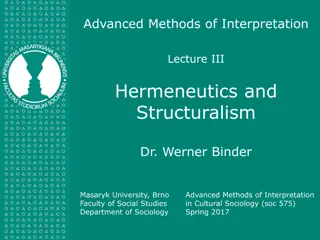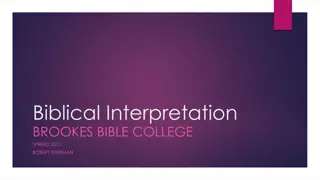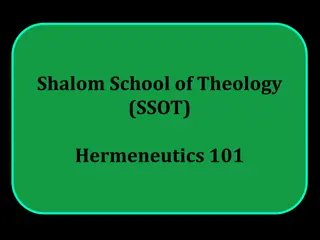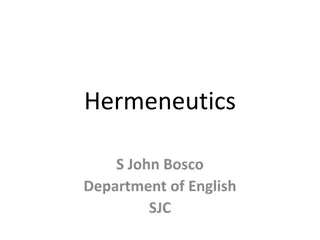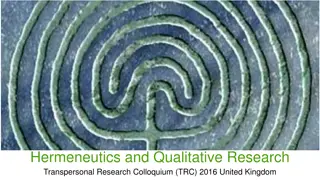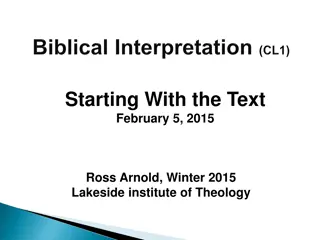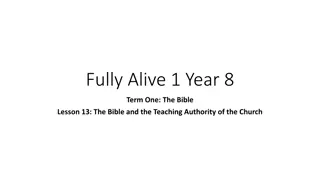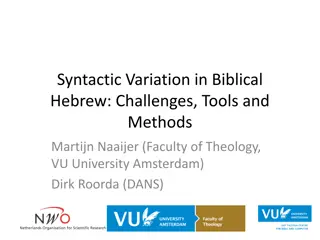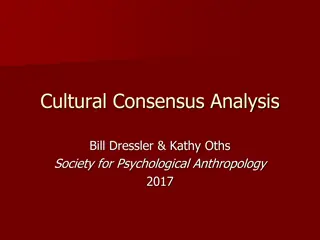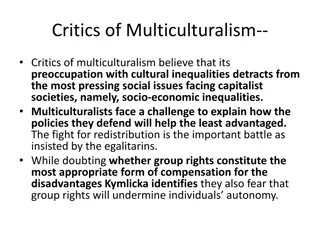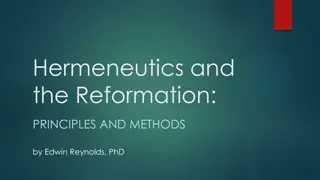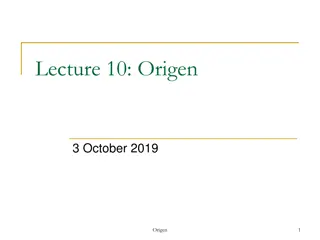Historical and Cultural Context in Biblical Hermeneutics
Understanding the historical and cultural background is vital for interpreting biblical texts accurately. This includes exploring the relationship between history and literature, studying chronology, patriarchal periods, and significant events like the Exodus and United Monarchy. By delving into the ancient languages, contexts, and meanings, we can grasp the original intent of the scriptures and apply them meaningfully in modern contexts.
Download Presentation

Please find below an Image/Link to download the presentation.
The content on the website is provided AS IS for your information and personal use only. It may not be sold, licensed, or shared on other websites without obtaining consent from the author. Download presentation by click this link. If you encounter any issues during the download, it is possible that the publisher has removed the file from their server.
E N D
Presentation Transcript
Chapter 2 SETTING THE STAGE: HISTORICAL-CULTURAL BACKGROUND
CHAPTER OUTLINE Hermeneutics and the Relationship between History and Literature Chronology Historical-Cultural Background Archaeology Sample Exegesis (New Testament): Luke 2:1 20
HERMENEUTICS: HISTORY AND LITERATURE Since we live in a very different context, we must recapture God s original intended meaning as reflected in the text and framed by the ancient historical-cultural context. Once we understand the meaning of the text in its original context, we can apply it to our lives in ways that will be just as relevant. J. Scott Duvall and J. Daniel Hays, Grasping God s Word.
HISTORY AND LITERATURE The text comes to us in the form of ancient languages such as Greek and Hebrew. Since both the biblical languages and other parts of biblical culture and history are inextricably intertwined, this not only requires translation of these texts into a language we can understand (English) but also has important implications for the need to study various other aspects of this historical-cultural embeddedness.
CHRONOLOGY The Old Testament Period The Primeval Period Covers the period between Genesis 1 11, encompassing the time span between creation to the birth of Abram. The biblical storyline focuses particularly on salvation history, that is, the record of God s mission in carryout out his plan of redemption for sinful humanity in and through the Messiah. Creation, fall, redemption
THE PATRIARCHAL PERIOD Date Person/Event Scripture 2166 1991 Abraham Genesis 11:26 25:11 2091 1876 Patriarchal Age Genesis 12 50 1876 1446 Bondage in Egypt Exodus 1 12:30 The Hebrew people, and therefore God s covenant promises and all that God had created, face a great challenge in the people s bondage in Egypt (1876 1446 B.C.). Yet, God heard their groaning, and God remembered his covenant with Abraham, with Isaac and with Jacob (Exod. 2:24).
EXODUS TO UNITED MONARCHY Date Person/Event Scripture 1446 The Exodus Exodus 12:31 15:21 1406 Entrance into Canaan Joshua under Joshua 1360 1060 Period of the Judges Judges 1070 1010 Samuel 1 Samuel 7:2 1050 1009 Saul 1 Samuel 10; cf. Acts 13:21 1009 969 David 2 Samuel 5:5 971 931 Solomon 1 Kings 11:42
EXODUS TO UNITED MONARCHY Through the exodus and the Mosaic covenant established at Sinai, God calls Israel into being as a nation set apart for him. God then continues to be faithful to his covenant promises by taking the people across the Jordan to settle the land that he promised Israel s forefathers (1406 B.C.). The period of the judges ensues as God continually raises up leaders to bring Israel back to faithfulness to the covenant (1360 1060 B.C.). The united monarchy then begins with the anointing of Saul as king (1050 B.C.). With regard to biblical literature, this time period proved to be significant because the Psalms and wisdom literature flourished during this time period as David and Solomon became the archetypal psalmist and embodiment of wisdom, respectively.
DIVIDED MONARCHY Date Person/Event Scripture 931 Division of the Kingdom 1 Kings 12:19 723/2 Assyrian Exile 2 Kings 17:6 First deportation to Babylon 605 Daniel 1 597 Second Deportation to Babylon 2 Kings 24; 2 Chronicles 36 Third deportation to Babylon 587 Jeremiah 38 45
DIVIDED MONARCHY The era of the divided monarchy encompasses the period from the death of Solomon until the collapse of the northern and southern kingdoms in 723/2 B.C. and 587 B.C, respectively. That pressure will lead to Israel and Judah s breaking of the covenant and her spiritual apostasy and worship of other gods. Breaking the covenant, in turn, means that Israel and Judah incur the curse of the Mosaic covenant exile from the promised land.
EXILE AND RETURN Person Date/Event Scripture Third deportation to Babylon 587 Jeremiah 38 45 Decree of Cyrus allowing return 538 Ezra 1 4 Work on temple renewed under Darius 520 Haggai; Ezra 5 6 483 73 Xerxes and Esther; Purim Esther 458 Return of Ezra to Jerusalem Ezra 7 10 Artaxerxes allows Nehemiah to return 444 Nehemiah End of Old Testament prophetic period 430 Malachi
EXILE AND RETURN If the exodus serves as the paradigmatic event of redemption, the exile represents the paradigmatic event of judgment. In due course, God calls the Persian ruler, Cyrus, to defeat the Babylonians who captured Israel (Isaiah 44:24 45:7), and he issues a decree to bring God s people back to the Promised Land (538 B.C.). Subsequently, the people begin to rebuild the temple. Construction is completed in 515 B.C. God proves faithful, and a believing remnant is restored from exile. Though the temple is rebuilt, however, it is not as glorious as Solomon s temple, nor does the glory of God descend to take up his presence there again. God s fulfillment of his promises awaits a future time.
SECOND TEMPLE PERIOD The second temple period is the period between the rebuilding of the temple after the return from exile in 515 B.C. and its destruction by the Romans in A.D. 70. Many important events happen during this period which causes us to find ourselves in a very different place from the Old Testament when we open the Gospels. Thus, we encounter in the Gospels various Jewish sects the Pharisees, the Sadducees, the Herodians, the Zealots whose roots lie in events that transpired in the centuries preceding the Incarnation.
BABYLONIAN AND PERSIAN PERIOD Date Person/Event Scripture Work on temple renewed under Darius 520 Haggai; Ezra 5 6 483 73 Xerxes and Esther; Purim Esther Return of Ezra to Jerusalem 458 Ezra 7 10 Artaxerxes allows Nehemiah to return 444 Nehemiah End of Old Testament prophetic period 430 Malachi
BABYLONIAN AND PERSIAN PERIOD The cataclysmic event transpiring toward the end of Old Testament history is the Babylonian captivity of God s people Israel. The Babylonians (Nebuchadnezzar) had wrested control from Egypt at the famous battle of Carchemish at the Euphrates in 605 B.C. (Jer. 46:2). In the year 539, Darius the Mede seized power (Dan. 5:30), soon replaced by the Persian Cyrus, who in 538 issued a decree allowing the Jews to return.
THE HELLENISTIC PERIOD Date Person/Event Significance 333 Alexander the Great Hellenization seizes world domination 198 Seleucids seize control of Hellenization (contd.) Palestine 175 64 Antiochus Epiphanes IV abomination causing rules Palestine, radical desolation program of Hellenization
THE HELLENISTIC PERIOD In 333, the Greeks (Alexander the Great) took over world domination at the battle of Issus. The Greek translation of the Old Testament, the Septuagint (LXX), prepared in the third century B.C., became the version used by the early Christians and most frequently cited by the New Testament writers (cf. Letter of Aristeas). The New Testament would be written, not in Hebrew or Aramaic, but in Greek. After Alexander s death in 323, his empire was divided, issuing in two major dynasties: the Ptolemies in Egypt and the Seleucids in Mesopotamia and Syria. Things came to a head during the reign of Antiochus Epiphanes IV (175 164)
THE MACCABEAN PERIOD Date Person/Event Significance 164 Feast of Dedication Maccabean revolt, rededication of the Temple 142 Judah becomes independent Rise of Sadducees, Pharisees, Dead Sea community
THE MACCABEAN PERIOD The temple was rededicated in 164 B.C. (the Feast of Dedication; see John 10:22). In 142 B.C., Judah became independent until the Romans conquered Palestine under Pompey in 63 B.C. Several movements emerged that continued to exist until the time of Jesus, such as the Sadducees (aristocracy) and the Pharisees (religious reformists, persecuted by Alexander Jannaeus who ruled 103 76 B.C.). The Dead Sea community, likewise, arose during the mid-second century B.C.
THE ROMAN PERIOD Date Person/Event Significance Roman general Pompey conquers Palestine Roman vassal rulers in charge of Palestine timeof Christ 63 at Emperor Augustus presides over Golden Age of Rome Roman peace (Pax Romana; compared with Christ; Luke 2:1) 31 B.C. A.D. 14 3/2 B.C. Birth of Christ Virgin birth Slaughter of infants, head of Herodian dynasty 1 B.C. Death of Herod the Great Ruled when Jesus began ministry and when he was crucified A.D. 14 37 Emperor Tiberius
THE ROMAN PERIOD At the time of Jesus birth in 3/2 B.C., Herod the Great ruled the region, though he died soon afterward (1 B.C.) and was succeeded by Archelaus. In Jesus day, Herod Antipas was in charge of Galilee (Mark 6:14; Luke 13:32). Emperor Augustus (31 B.C. A.D. 14) presided over a golden period of peace (the Pax Romana). When John the Baptist and Jesus commenced their ministries, the rule had passed to Emperor Tiberius (A.D. 14 37; cf. Luke 3:1) who was still in charge at the time of Jesus crucifixion in the spring of 33, with Pontius Pilate serving as the procurator or prefect of Judea.
THE NEW TESTAMENT PERIOD Chronology Jesus The Early Church and Paul The Rest of New Testament
CHRONOLOGY OF JESUS LIFE Event Approximate Date Scripture Jesus Birth 3/2 B.C. Matt. 1:18 25; Luke 2:1 20 Death of Herod the Great Beginning of John the Baptist s Ministry 1 B.C. Josephus, Ant. 17.6.4 167 A.D. 29 Luke 3:1 3 pars. Beginning of Jesus Ministry Fall 29 John 1:19 51 Jesus First Passover Spring 30 John 2:13 22 Jesus Second Passover Spring 31 Matt. 12:1 pars. Jesus at Feast of Tabernacles Fall 31 John 5 Jesus Third Passover Spring 32 John 6 Jesus at Feast of Tabernacles Fall 32 John 7 8 Jesus at Feast of Dedication Winter 32 John 10:22 39 Final Passover, Crucifixion, Resurrection, Ascension, Pentecost Gospels passion narratives; Acts 1 2 Spring 33
CHRONOLOGY OF PAULS LIFE AND LETTERS Event Approximate Date Scripture Turn of the era? Paul s Birth Jesus Crucifixion, Resurrection, Ascension, and Pentecost Gospels passion narratives; Acts 1 2 Spring 33 Paul s Conversion 34 Acts 9:1 19 First Missionary Journey 47 48 Acts 13 14 Galatians 48 Jerusalem Council 49 Acts 15
CHRONOLOGY OF PAULS LIFE AND LETTERS Event Second Missionary Journey Antioch to Corinth Thessalonian Letters from Corinth Appearance before Gallio Approximate Date Scripture 49 51 Acts 16 18 Acts 18:11 Acts 18:12 Third Missionary Journey 51 54 Acts 19 21 Acts 20:31 1 Cor. 5:9, 11 Acts 19:10 2 Cor. 2:4; 7:8 Acts 20:1 2 2 Cor. 13:1 2 Rom. 16:1 2, 23 3-Year Stay in Ephesus Severe letter 1 Corinthians Sorrowful letter 2 Corinthians (from Macedonia) Stay in Corinth Romans (from Corinth) 53/54 54/55 55
CHRONOLOGY OF PAULS LIFE AND LETTERS Event Jerusalem Approximate Date Scripture 55 Acts 21 23 Arrest Acts 21:27 40 Imprisonment in Caesarea Defense before Felix, Festus, Agrippa Journey to Rome Voyage and Shipwreck Winter in Malta 55 57 Acts 24 27 57 58 Acts 27 Acts 28:1 10 First Roman Imprisonment Prison Epistles: Colossians, Philemon, Ephesians, Philippians 58 60 Acts 28:11 30
CHRONOLOGY OF PAULS LIFE AND LETTERS Event Date Paul s Release Further Travels 1 Timothy Titus Great Fire of Rome, Persecution of Christians under Emperor Nero 60 60 66 64 Paul s Arrest and Second Roman Imprisonment 2 Timothy 66 Paul s and Peter s Martyrdoms 66/67 Outbreak of Jewish War 66 Destruction of Jerusalem 70
THE REST OF THE NEW TESTAMENT James Hebrews Johannine corpus
PRIMARY SOURCES While the biblical documents must remain primary, extrabiblical information can be used in tandem and can helpfully illuminate aspects of the biblical story that may lie in the background and be assumed by the biblical writer without being spelled out explicitly. Primary Sources Ancient Near Eastern Literature The Old and New Testament Apocrypha The Old Testament Pseudepigrapha The Dead Sea Scrolls Other Relevant Primary Sources
PRIMARY SOURCES Ancient Near Eastern Literature Texts from the ancient Near East contain nearly every genre we find in the Old Testament. These texts come to us from all over the ancient Near East including Egypt, Mesopotamia, Anatolia, and Persia in languages including Ugaritic, Akkadian, Sumerian, Hittite, and Egyptian covering over two millennia. List of Sources
PRIMARY SOURCES Old Testament and New Testament Apocrypha The Greek word apocrypha originally meant things that are hidden. The designation Apocrypha may also refer to the mysterious or esoteric nature of some of the contents of these books or to their spurious or heretical nature (or both).
PRIMARY SOURCES Old Testament Aprocrypha represents several different genres: historical writings (1 Esdras, 1 2 Maccabees); moralistic novels (Tobit, Judith, Susanna, Bel and the Dragon); wisdom or devotional literature (Wisdom of Solomon; Sirach, also called Ecclesiasticus; Prayer of Manasseh; Prayer of Azariah; Song of the Three Young Men); pseudonymous letters (Letter of Jeremiah); and apocalyptic literature (2 Esdras).
PRIMARY SOURCES Old Testament Apocrypha Because of their inclusion in the Vulgate, the books of the Apocrypha were considered part of Scripture by the medieval church. In 1546, the Council of Trent declared them canonical except for 1 2 Esdras and the Prayer of Manasseh. New Testament Apocrypha There are also New Testament Apocrypha that emerged in the second and subsequent centuries of the Christian era, consisting of spurious Gospels, Acts, and Apocalypses.
PRIMARY SOURCES New Testament Apocrypha Many of these writings have in common the underlying motivation to fill in perceived gaps in Scripture, frequently resulting in heterodox (false) teaching.
PRIMARY SOURCES Old Testament Pseudepigrapha (1) apocalyptic and related literature (1 2 Enoch; 2 3 Baruch, 4 Ezra, Sibylline Oracles); (2) testaments (Testaments of the Twelve Patriarchs); (3) pseudonymous epistles (Letter of Aristeas); (4) wisdom or devotional literature (Psalms of Solomon; Odes of Solomon; Psalm 151); (5) expansions of Old Testament material (Jubilees; Joseph and Aseneth; Jannesand Jambres; Assumption of Moses, Martyrdom and Ascension of Isaiah); (6) religious novels and philosophical treatises (3 4 Maccabees).
PRIMARY SOURCES On the positive side, the historical information provided by books such as 1 Maccabees provides an indispensable source for this particular period in Jewish history. Also, while not inspired or authoritative, many of these writings reflect the various religious beliefs of the Jewish people in the Second Temple period and thus provide helpful background information for the study of the New Testament.
PRIMARY SOURCES On the negative side, scholars have stressed that some of the teaching in these writings are heterodox, that is, not in conformity with the doctrines affirmed in the canonical books. In this regard, it is interesting to note that the New Testament Letter of Jude makes reference to several pseudepigraphical writings, most notably 1 Enoch.
PRIMARY SOURCES The Dead Sea Scrolls Constituted the major archeological find related to biblical studies in the twentieth century. The Qumran writings include both biblical manuscripts, which predate the previously earliest extant Old Testament manuscripts by as many as a thousand years, and sectarian writings. The biblical documents discovered at Qumran, including the famous Isaiah Scroll, have provided scholars with early readings of the Hebrew Scriptures, which has enabled them to make progress in ascertaining the original reading of specific Old Testament passages.
PRIMARY SOURCES The Dead Sea Scrolls The Dead Sea Scrolls provide a fascinating glimpse into the life of a Jewish sect that most likely arose in the Maccabean era around the middle of the second century BC and continued through the first Jewish revolt in AD 66 73. This isolated community was a sect that defined itself over against the Jerusalem establishment and engaged in its own distinctive religious and communal practices.
PRIMARY SOURCES The Dead Sea Scrolls The community s critical stance toward the corrupt Jerusalem priesthood provides an antecedent for Jesus challenge of the corruption of the Jerusalem temple ritual during his ministry (Matt. 21:12 17 pars.; John 2:13 22). The community s use of Scripture also provides a fascinating precedent for John the Baptist s self- identification as a voice crying in the wilderness (cf. Isa. 40:3).
PRIMARY SOURCES Other Relevant Sources Rabbinic literature (including the Mishnah, the Talmuds, and the Tosefta); the Hellenistic philosopher Philo; the Jewish historian Josephus; the Targums (Aramaic paraphrases of the Old Testament); Greco-Roman sources.
SECONDARY SOURCES Study Bibles Background Commentaries Old and New Testament Introductions Commentaries on each book of the Bible New Testament use of the Old
ARCHAEOLOGY The Old Testament Archaeology has served to verify, illumine, or supplement the biblical record. For this reason, the interpreter does well in taking archaeological data into account in his or her use of the historical- cultural leg of the hermeneutical triad. The New Testament Life of Jesus Life of Paul New Testament Writings
NEW TESTAMENT ARCHAEOLOGY Jesus research Evidence that Jesus was crucified on the rock now seen inside the Church of the Holy Sepulchre The remains of a crucified man named Jehohanan The Praetorium, the official residence of the Roman governor: Pilate s dwelling was probably in the Upper City and not in the Fortress of Antonia The Pool of Bethesda described in John 5:2 9 The Temple Mount: monumental pre-70 structures located south of the southern retaining wall of the Temple The walls and gates of Jerusalem Pre-70 synagogues at Gamla, Masada, and the Herodium No archaeological discovery has disproved any information regarding Jesus given in the canonical Gospels.
NEW TESTAMENT ARCHAEOLOGY Paul Particularly important is the Gallio Inscription, which allows us to date Gallio s governorship in the province of Achaia to between the summer of the year 51 and the summer of 52. Most likely, therefore, the Jews brought charges against Paul in the summer or fall of the year 51 per Acts 18:12. With Paul s ministry in Corinth spanning 18 months (Acts 18:11) and his departure from Corinth taking place sometime after the Gallio incident, Paul s arrival in Corinth can be dated to early 50. Thus the Gallio inscription, as one of the few reasonably fixed dates in New Testament history, provides an anchor for an absolute chronology of Paul s life, letters, and ministry.
CONCLUSION Christianity is a historical religion, and Scripture presupposes that God revealed himself in human history. Therefore, the task of the receptor in the modern cultural framework is to recapture the total framework within which the sacred writer communicated and to transfer that message to our own day. The cultural aspects presupposed in the passage help interpreters get behind the words to the underlying message, understood by the original readers but hidden to the modern reader (Osborne, Hermeneutical Spiral, 166).
GUIDELINES Some cultural matters mentioned in the Old Testament clearly are limited in application and are not repeated in the New Testament (cf. Hebrews). Some Old Testament cultural standards are repeated later on in the Bible and thus continue to be valid. In many cases, biblical customs contain an underlying principle that remains applicable today. 1. 2. 3.
SAMPLE EXEGESIS The birth of Jesus (Luke 2:1 20)


